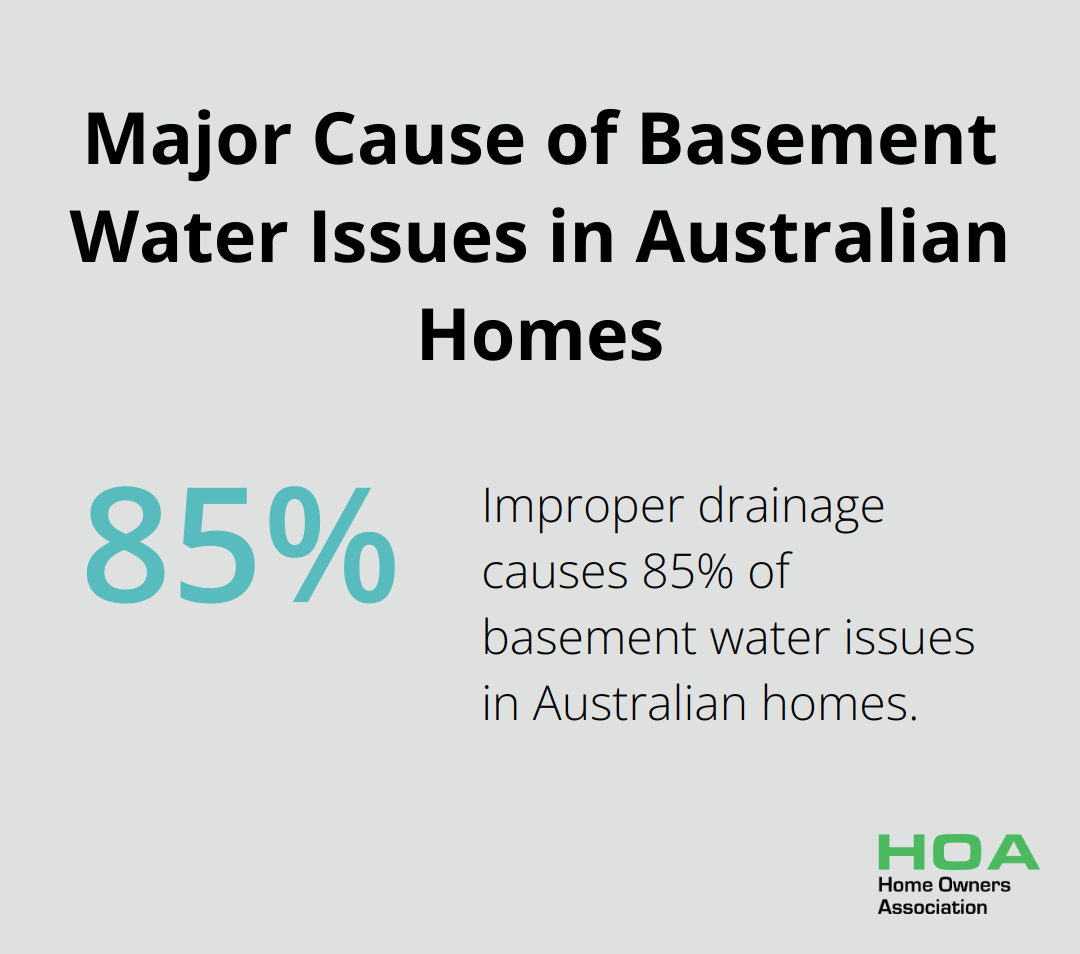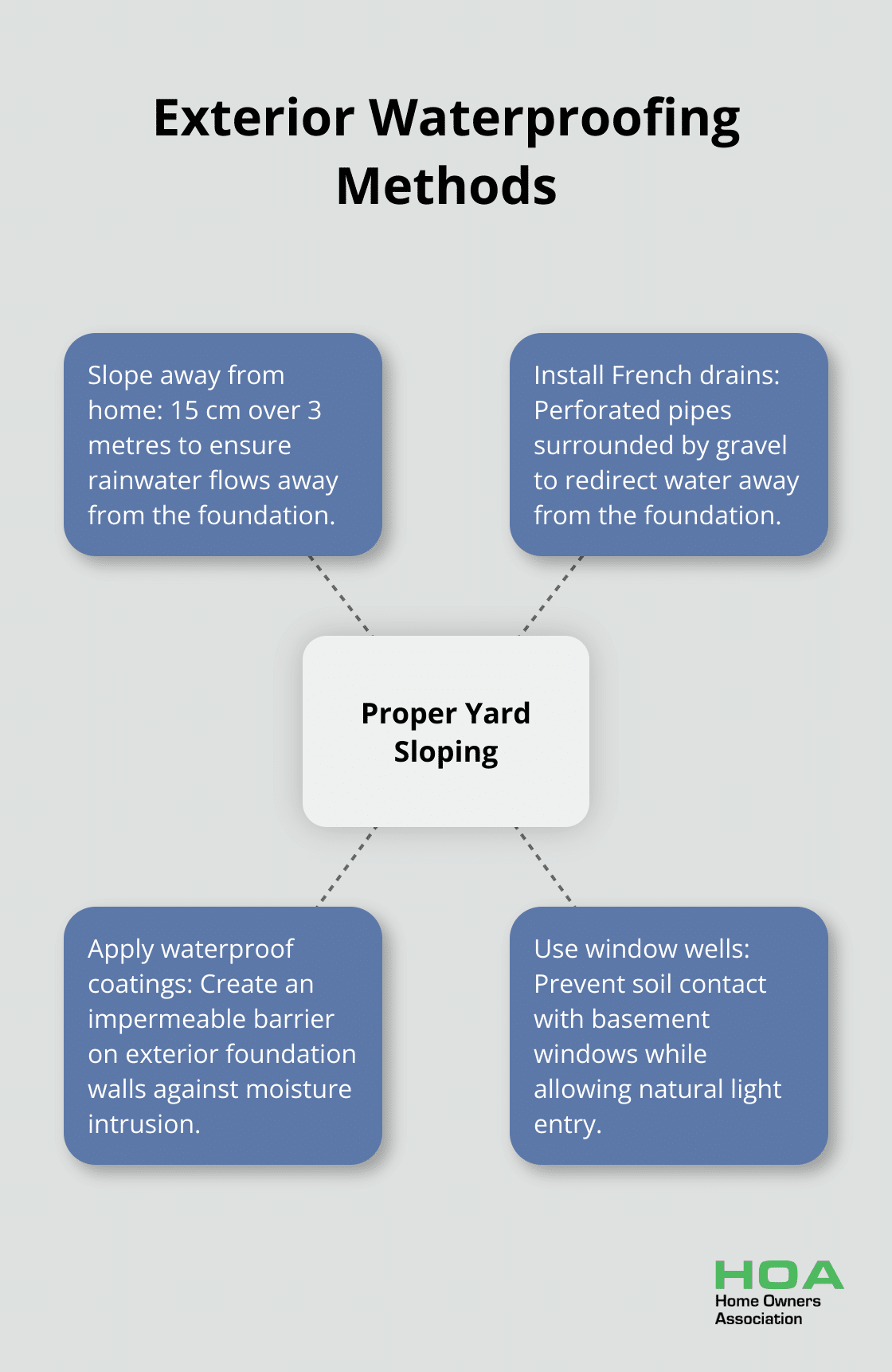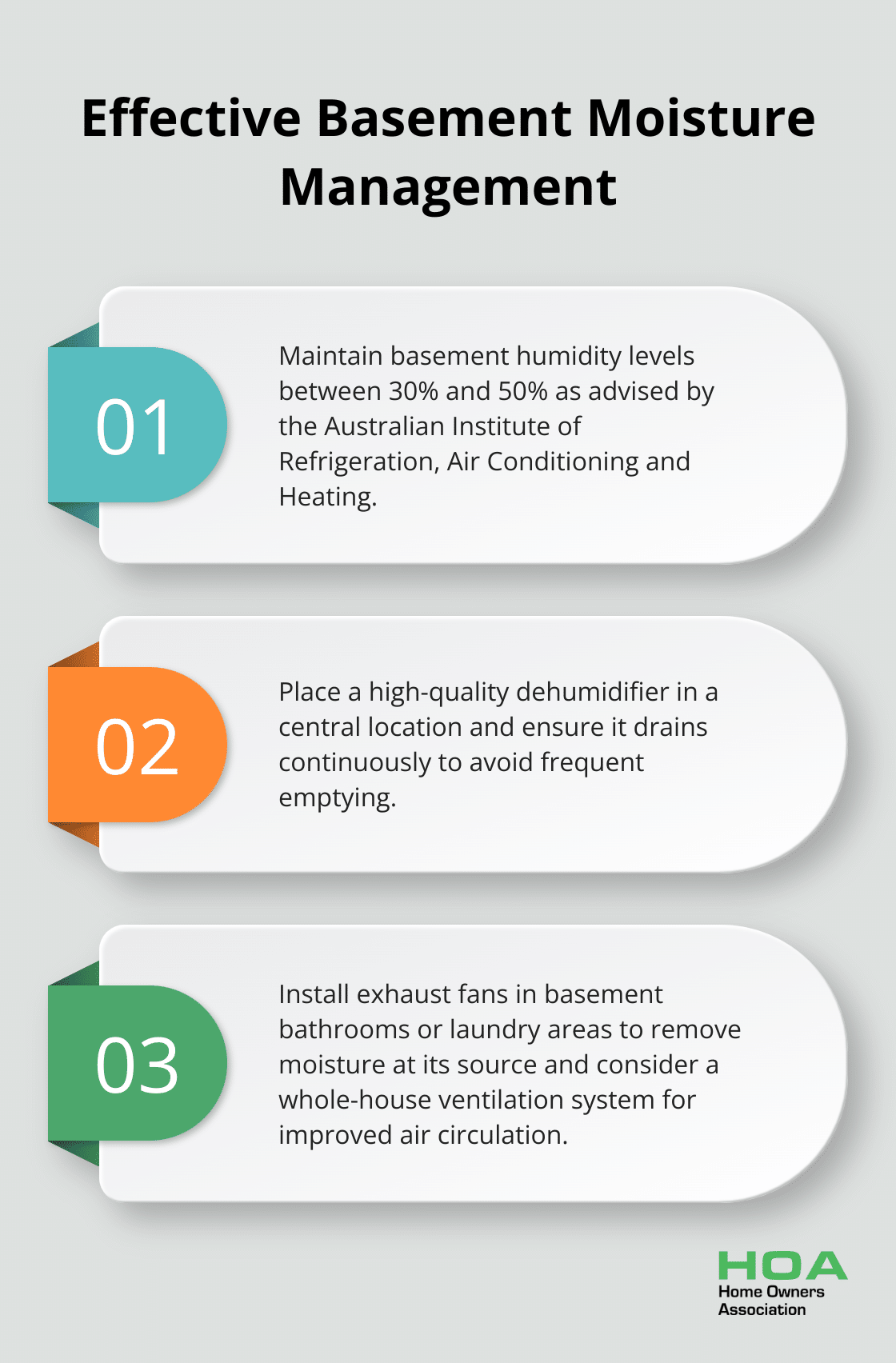
At Home Owners Association, we understand the importance of a dry basement for your home’s value and your family’s health.
Basement waterproofing is a critical step in protecting your property from water damage and mould growth.
This guide will walk you through effective methods to keep your basement dry and secure, from exterior solutions to interior techniques.
Why Water Enters Your Basement
The Root Causes of Basement Water Problems
Water infiltration in basements plagues many homeowners across Australia. At Home Owners Association, we’ve encountered numerous cases of basement water issues. Understanding the primary causes of these problems is essential for effective waterproofing.
Poor drainage around the foundation tops the list of culprits. When rainwater doesn’t flow away from your home properly, it can penetrate through cracks in the foundation walls or floor. A CSIRO study reveals that improper drainage accounts for 85% of basement water issues in Australian homes.

Hydrostatic pressure presents another significant challenge. This occurs when the water table rises, forcing water up through the basement floor or walls. Areas with high rainfall or proximity to water bodies often face this issue.
Foundation cracks, whether from settling or subpar construction, provide easy entry points for water. Even hairline cracks allow substantial moisture to seep in over time.
How to Spot Water Damage Signs
Early detection of water damage can save you thousands in repairs. Watch out for these indicators:
- Musty odours (often the first sign of moisture problems)
- Efflorescence (white, powdery deposits on walls)
- Peeling paint or wallpaper
- Mould growth (appearing as dark spots on walls or ceilings)
- Water stains (discoloured patches on walls, floors, or ceilings)
The Consequences for Your Home and Health
Water in your basement isn’t a mere inconvenience; it can lead to serious repercussions. Structural damage to your home’s foundation may occur, potentially costing tens of thousands of dollars to fix. The Australian Building Codes Board estimates that water damage constitutes 34% of all building defect claims.
Damp basements create ideal conditions for mould and mildew growth, triggering allergies and respiratory issues.
From a financial perspective, a dry basement can boost your property value by 10-15% (according to real estate experts). It also enhances your home’s appeal to potential buyers if you decide to sell.
The Importance of Professional Assessment
Given the complexity of basement water issues, professional assessment proves invaluable. Experts can identify hidden problems and recommend tailored solutions. Home Owners Association members benefit from access to trusted professionals who can provide comprehensive evaluations.
Moving Towards Effective Solutions
Now that we’ve explored the causes and consequences of basement water problems, it’s time to discuss solutions. In the next section, we’ll examine exterior waterproofing methods that will help keep your basement dry and secure. These techniques form the first line of defence against water infiltration, setting the foundation for a moisture-free basement.
Fortifying Your Home’s Exterior Against Water Intrusion
Reshaping Your Landscape for Optimal Drainage
The first defence against water intrusion is proper grading. Your yard should slope away from your home at a rate of at least 15 cm over 3 metres. This gradient ensures that rainwater flows away from your foundation rather than pools around it.

To achieve this, you might need to add soil near your foundation to create the necessary slope. Use clean fill dirt for this purpose, as it compacts well and doesn’t retain water. Avoid topsoil, which can absorb water and lead to settling.
For homes with basements below grade, install window wells. These structures prevent soil from directly contacting your basement windows while allowing natural light to enter. Ensure that window wells have proper drainage systems to prevent water accumulation.
Implementing Robust Drainage Systems
French drains are an excellent solution for redirecting water away from your home’s foundation. These systems consist of perforated pipes surrounded by gravel, installed around the perimeter of your home at the footing level.
When you install a French drain, maintain a consistent slope of at least 1% to ensure proper water flow. The drain should empty into a dry well, storm sewer, or daylight at a point downhill from your home.
For areas with heavy rainfall or high water tables, combine French drains with a curtain drain system. This additional drainage layer intercepts water before it reaches your foundation, providing an extra level of protection.
Applying Waterproof Barriers to Foundation Walls
Waterproof coatings applied to exterior foundation walls create an impermeable barrier against moisture intrusion. These coatings come in various forms, including liquid rubber systems that can achieve 1200% elongation capacity, stretching twelve times their original size to accommodate foundation movement.
Before you apply any coating, thoroughly clean and repair the foundation surface. Fill any cracks or holes with hydraulic cement to ensure a smooth application surface. Apply the coating in multiple thin layers rather than one thick coat for better adhesion and durability.
For optimal protection, use a dimpled membrane over the waterproof coating. This creates an air gap between the soil and foundation wall, allowing any water that does penetrate to drain down to the French drain system.
Professional Expertise for Complex Projects
Exterior waterproofing is a complex process that often requires excavation around your home’s foundation. While some homeowners might attempt this as a DIY project, professional assistance is highly recommended for this task. Experienced contractors (such as those associated with Home Owners Association) specialise in exterior waterproofing, ensuring the job is completed correctly and efficiently.
These exterior waterproofing methods form a strong defence against water damage. However, they’re just one part of a comprehensive waterproofing strategy. The next section will explore interior waterproofing techniques that work in tandem with these exterior methods to keep your basement dry and secure.
Mastering Interior Waterproofing Techniques
The Power of Sump Pumps
Sump pumps form a critical defence against basement moisture. These devices collect and expel water that seeps into your basement, preventing water damage. Sump pumps play a critical role in protecting homes from sump water damage, particularly in areas susceptible to flooding or heavy rains.
Install your sump pump at the lowest point of your basement floor for optimal effectiveness. The discharge pipe should extend at least 3 metres away from your home’s foundation and empty into a well-drained area.
A battery backup system (recommended by the Australian Building Codes Board) ensures continuous operation during power outages, which often coincide with severe weather.
Waterproof Coatings for Added Protection
Waterproof sealants and coatings create an effective barrier against moisture penetration through basement walls and floors. These products range from paint-on sealers to thick epoxy coatings.
Clean and repair the surface thoroughly before application. Fill cracks larger than 3mm with hydraulic cement. Use a high-quality masonry waterproofer that withstands at least 10 psi of hydrostatic pressure.
Apply the coating in thin, even layers. Allow each layer to dry completely before adding the next. Most products require at least two coats for optimal protection. Interior sealants and coatings can be applied to walls and floors to prevent moisture penetration.
Effective Moisture Management
Control residual moisture with dehumidification and ventilation. The Australian Institute of Refrigeration, Air Conditioning and Heating advises maintaining basement humidity levels between 30% and 50%.

Place a high-quality dehumidifier in a central location. Ensure it drains continuously to avoid frequent emptying. Install exhaust fans in basement bathrooms or laundry areas to remove moisture at its source.
Consider a whole-house ventilation system to promote air circulation throughout your home, including the basement. For basements with windows, use window wells to allow natural ventilation while preventing water ingress. Ensure window wells have proper drainage and covers to keep out debris and rainwater.
Professional Assessment and Installation
While some homeowners might attempt interior waterproofing as a DIY project, professional assistance often yields superior results. Experienced contractors (such as those associated with Home Owners Association) specialise in interior waterproofing, ensuring the job is completed correctly and efficiently.
These professionals can assess your specific situation, recommend the most effective solutions, and implement them with precision. Their expertise can save you time, money, and potential headaches in the long run.
Final Thoughts
Waterproofing your basement protects your home’s longevity and your family’s wellbeing. We at Home Owners Association have explored various methods to keep water out, from exterior solutions to interior techniques. Professional assessment helps develop a tailored waterproofing strategy, as experts can identify hidden issues and recommend suitable solutions for your specific situation.
A dry, waterproof basement offers substantial long-term benefits. It protects your home’s structural integrity, prevents mould growth, and creates a healthier living environment. A waterproof basement also increases your property value and expands your usable living space, opening up possibilities for additional rooms or storage areas.
Effective basement waterproofing requires ongoing vigilance and prompt attention to any signs of moisture. For personalised advice and access to trusted professionals in Melbourne, Australia, consider joining the Home Owners Association. We support you in maintaining a dry, secure basement and a healthy home for years to come.





